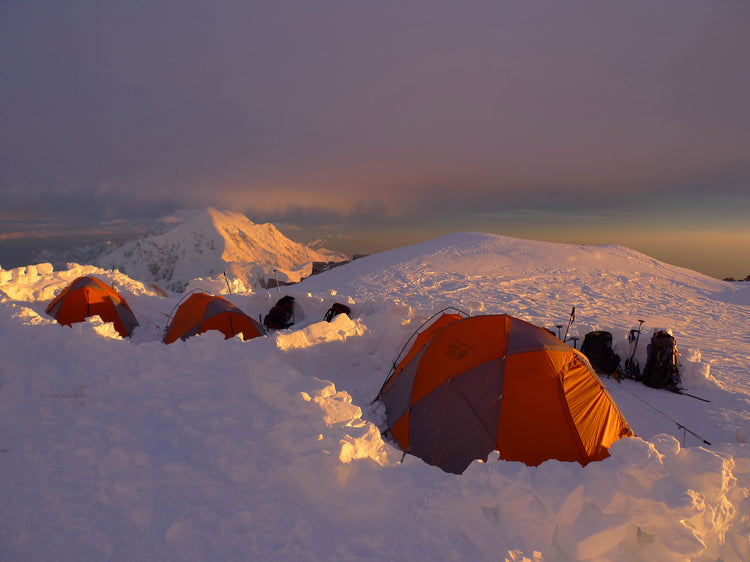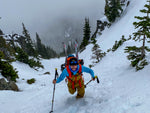When you think of camping, you probably think of long summer evenings, lake days, and toasty campfires. And while summer camping is all well and good, there’s something to be said for winter camping as well; crisp mornings, beautiful early sunsets, and crystal clear night skies are just some of the reasons you might want to give it a try. Whether you’re camping in your snowy backyard or bivying up on a peak, here are some necessary gear and easy tips for cold camping.
Home Sweet Home: 4-Season Tents
If you’re camping in the summer, you can get away with almost any old 3-season tent, so long as it’s water and bug-proof. But if you’re cold camping, you’ll want to invest in something that holds up a bit better in freezing temps, and in the weather events that tend to accompany them. That’s why you’ll want to go for a 4-season expedition tent, something that can stand up to heavy snows and intense storms. Built with a rigid structure, thick walls to trap heat, and rain flys that extend to the ground, 4-season tents are usually heavier and bulkier than their 3-season counterparts, but are well worth it. The guides over at RMI Expeditions have consistently picked the Black Diamond Firstlight as their preferred 4 season tent. Also, don’t forget to vent your tent, it may seem counterintuitive but if you don’t, you’ll get condensation on the inside, which can freeze and lower temps.

Here at Whittaker Mountaineering, our founding family has a bit of experience with expedition tents… Lou Whittaker helped design and test the first dome tent for Jansport in the early 70s!
Respect the R-Value: Sleeping Pads
Sleeping pads are especially important when you’re cold camping - they get you off the ground and away from that cold, damp tent floor. The level of insulation a sleeping pad provides is called its R-value. R-values signify how well a material resists heat conduction, so the higher the R-value, the better the resistance, and the less heat gets transferred from your warm body to the cold ground. Sleeping pad values usually range from 1-7, and for cold camping, we recommend you find one with an R-value of at least 5. The Therm-a-Rest NeoAir XTherm MAX is a constant Guide Pick™ due to its awesome comfort level and packability.
Usually, the higher the R-value of a pad, the thicker and less portable it is. To get around that issue, a lot of the guides over at RMI Expeditions go with a two-pad system - a super packable blow-up pad and a closed cell foam cell. When you use two pads together, their R-values effectively add up, and it’s hard to get much more insulated than that! We recommend the Therm-a-Rest NeoAir XLite for a blowup pad and the Exped FlexMat as a closed-cell pad. Plus, your closed cell pad can be used to sit or stand on when you’re outside your tent, insulating you from the snow!
Get Down To It: Sleeping Bags
There are few things better than crawling into your sleeping bag after a long day of climbing, especially if that bag is warm enough to make you forget the howling wind and freezing temps outside your tent. While the actual temp of your sleeping bag should be determined by the temps on your adventure, there are a few things to keep in mind when looking for any cold weather bag. Also, keep in mind that the temperature rating of a sleeping bag is often the minimum temperature you can safely use it in, not the temperature you’ll be comfortable at (that’s why it’s important to read the details!).

You’ll most likely want to look for a down bag if you plan on sleeping in freezing temps. Down insulation tends to hold warmth better than synthetic, although it is a bit heavier. Our favorite down bag for cold-weather camping is the Marmot Col -20, which checks all the above boxes and is super popular among RMI Expeditions guides. If you don’t have the cash for an expensive new sleeping bag, or really really love your 3-season bag, you can look into buying a sleeping bag liner like the Sea to Summit Reactor Extreme Liner which can add up to 25 degrees of warmth to your bag.
Hopefully, those gear suggestions get you started on cold camping! Be sure to check out our Mountain Logic Guide to Sleep Systems for more info on bags and pads, and our 5 Tips to Staying Warm in the Mountains for more info on keeping the cold at bay.
Till next time, Happy Climbing!



Very well written article. Thanks for the info!